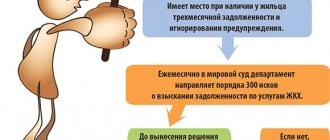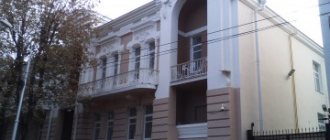What is the coefficient for increasing payment for utility bills?
Starting from 15, an increased level of payment for utility services began to be applied. The first digit is 1.1. The fact is that not everyone has installed these resource consumption devices, so at the legislative level it was decided to introduce a different coefficient and it is 1.6. This figure, according to the facts, has almost always increased and has increased significantly within two years, and will also increase further.
What it is? This percentage expression is numerical; the base tariff is increased by it.
Application
The idea with such a coefficient appeared among business executives quite a long time ago. The first records about it were formed in our laws back in 2011.
When the resolution was issued, even then one of the supporting points was the idea of transferring the money that can be received as the difference in payment using a multiplying factor for various manipulations to save energy and improve energy efficiency.
Then, in 2013, the proposal to credit payment for services received with an increased coefficient was fully formalized.
The increasing coefficient can be considered an important condition for the implementation of the basic law on energy saving and energy efficiency (No. 261 - Federal Law). Having analyzed recommendations 306 and 354, we can come to the conclusion that changes in utility bills came into force back in 2013, but people are still trying to get around them by any means.
And for some reason, the constituent entities of Russia did not calculate such coefficients and did not set standards. Why did this happen? Maybe there are gaps in our laws, maybe the irresponsibility of officials, or maybe political attitudes are to blame.
The most difficult thing in this situation was for public utilities. They saw official documentation about such a coefficient, but officials do not understand the standards. People waste resources senselessly by making low transfers, and no one can punish them.
Heating
In addition to intra-apartment measuring devices, the management organization must install general measuring equipment on multi-apartment buildings. If such devices are available, residents pay for the service not according to regulations, but based on consumption.
At the end of February 2021, the heating PC was lowered to 1.1. This is combined with the procedure for using money, which the management organization now has the right to dispose of with its own hands. In 2018, the coefficient is 1.1.
ATTENTION! The coefficient is applicable only to owners in the case of living or using the premises for social needs.
Water
In the absence of equipment for metering liquid consumption, if there is a real possibility of installing them, supplying organizations have the right to ask for an increasing factor. Total water absorption is paid according to official standards.
The water disposal system has not been used from the summer of 2016 to the current year, according to the decree of the Russian government. It turns out that the additional fee can only be charged for water. You can figure out how to pay for water with an increasing coefficient on your own. Unfortunately, sometimes the average person has to check the management company’s calculations several times.
HVS
The water supply fee can be calculated in the following way: the number of registered owners is multiplied by the cold water absorption standard, PC (1.5) and the regional tariff. This method of calculation is suitable for cold water supply to public services in St. Petersburg.
How it is used
Utility tariff is calculated according to a certain formula
When calculating the supply of services by the resource supply company, a legally established tariff is applied, calculated as follows:
P = n × N × Tcr
n is the number of tenants officially living in the house;
N is the established standard for consuming the service;
Tcr is a price indicator.
Such services are directly related to the number of people registered in the living space. If the devices are not installed, then the amount calculated using this formula will be increased by 1.6 times. In percentage terms this is -60.
Until 2021, such an increase was applied in relation to the norm. Now this indicator will be used when calculating, or in other words, the tariff indicator. An increased tariff is applied when charging for water disposal.
If there is any debt, interest will be charged.
Housing and communal services 2021: tariff increase from January 1, latest news
People who have their own housing pay utility bills every month. On the eve of the New Year, citizens are interested in how tariffs are changing and whether there will be an increase in prices, because this happens every year.
In order to prevent an unreasonable increase in the amount in the receipt, the relevant authorities regularly establish new laws in the State Duma. You need to know the nuances that will help reduce the cost of housing and communal services, because there are benefits and subsidies for certain groups of citizens.
Tariff increase
According to the legislation, the reform states that tariffs on January 1, 2020 should not exceed the tariffs in force on December 31. This is due to the fact that they are not increasing faster than last year’s inflation, and taxes are also increasing.
The law on increasing housing and communal services was adopted by the authorities back in 2021, which means that the inflation of the current year is taken into account. Now it is 4%. However, local authorities are able to independently increase or decrease the rate. An industry tariff agreement is concluded with all companies.
There is also an innovation, a bill on a “single receipt”. From here, changes will be made to Art. 155 of the Housing Code. However, this is still under consideration in the State Duma.
A single payment document will notify residents electronically. It is supposed to indicate all the information about how much and to whom the citizen needs to pay.
On August 6, 2021, the government revised the calculation of the amount for sewerage, heat supply and water supply services. This allows for the introduction of fairer tariffs. Tariffs are planned to be as loyal as possible for people.
Indices are the maximum possible increase in tariffs per year. Federal authorities allow the cost of utilities to increase, but they should not exceed these figures. Even in Moscow and the Moscow region, the meanings may differ. This also applies to St. Petersburg and the Leningrad region. Indices do not concern increases according to standards if there are no meters.
For example, there is an opportunity to install them in an apartment, but the residents do not want to or simply do not transmit the readings on time. In such a situation, 50% of the cost will be added to the amount, and the tariff will be calculated according to the standards.
The percentage increase may vary depending on the region. The ratio is as follows:
| Regions, districts, republics, territories | Increase percentage (%) |
| Chechen Republic | 6,5 |
| Kabardino-Balkarian Republic | 5,4 |
| The Republic of Dagestan | 5,2 |
| The Republic of Ingushetia | 5,1 |
| Moscow | 5 |
| Omsk | 5 |
| Buryatia | 5 |
| Yakutia | 5 |
| Jewish Autonomous Okrug | 4,9 |
| Novosibirsk | 4,9 |
| Karachay-Cherkess Republic | 4,9 |
| Kemerovo | 4,9 |
| Irkutsk | 4,8 |
| Tomsk | 4,7 |
| Amurskaya | 4,7 |
| North Ossetia | 4,7 |
| Transbaikalia | 4,7 |
| Krasnoyarsk region | 4,6 |
| Khakassia | 4,6 |
| Primorsky Krai | 4,5 |
| Altai region | 4,5 |
| Altai Republic | 4,4 |
| Novgorodskaya | 4,1 |
| Moscow | 4,1 |
| Tyva Republic | 4,1 |
| Krasnodar region | 4,1 |
| Lipetskaya | 4 |
| Novgorodskaya | 4 |
| Kostromskaya | 4 |
| Kirovskaya | 4 |
| Pskovskaya | 4 |
| Chukotka Autonomous Okrug | 4 |
| Yamalo-Nenets Autonomous Okrug | 4 |
| Kaliningradskaya | 4 |
| Tyumen | 4 |
| Tambovskaya | 4 |
| Smolenskaya | 4 |
| Magadan | 4 |
| Komi Republic | 4 |
| Tatarstan | 4 |
| Karelia | 4 |
| Adygea | 4 |
| Voronezh | 4 |
| Udmurtia | 4 |
| Kamchatka Krai | 4 |
| Volgogradskaya | 4 |
| Belgorodskaya | 4 |
| Arkhangelskaya | 4 |
| Khabarovsk region | 4 |
| Sakhalinskaya | 3,9 |
| Tula | 3,9 |
| Mari El | 3,9 |
| Saint Petersburg | 3,8 |
| Samara | 3,6 |
| Ryazan | 3,6 |
| Penza | 3,6 |
| Orlovskaya | 3,6 |
| Saratovskaya | 3,6 |
| Rostov | 3,6 |
| Sverdlovskaya | 3,6 |
| Yaroslavskaya | 3,6 |
| Khanty-Mansi Autonomous Okrug | 3,6 |
| Chelyabinsk | 3,6 |
| Ulyanovskaya | 3,6 |
| Tverskaya | 3,6 |
| Orenburgskaya | 3,6 |
| Vladimirskaya | 3,6 |
| Chuvash Republic | 3,6 |
| Stavropol region | 3,6 |
| Mordovia | 3,6 |
| Kalmykia | 3,6 |
| Bashkortostan | 3,6 |
| Leningradskaya | 3,6 |
| Astrakhan | 3,6 |
| Bryansk | 3,6 |
| Kursk | 3,6 |
| Kaluzhskaya | 3,6 |
| Kurganskaya | 3,6 |
| Ivanovskaya | 3,6 |
| Vologda | 3,6 |
| Murmansk | 3 |
| Perm region | 3 |
| Nenets Autonomous Okrug | 2,4 |
The meaning of innovation
For what purpose was the coefficient introduced? This question worries many tenants.
There are several reasons for this:
- This measure is specifically intended as an incentive for apartment owners to install metering devices. Of course, the weight was carried out so that resource savings were ensured. Also, the family budget is also significantly saved.
- Residential premises are equipped with meters, and this helps to save energy resources, and an increase in tariffs contributes to large charges.
- It happens that more people actually live in an apartment than are registered. It turns out that resources are consumed uneconomically. Therefore, many people deliberately do not install metering devices. Therefore, payment for such categories of citizens for resources is unreasonably low.
Increasing KBM OSAGO after an accident, if not at fault
Questions arise when the owner of the car was not driving, or the accident was not his fault. In the latter case, there is no change in the BMC. However, it will be necessary to prove that another person was the culprit of the incident. Typically, insurance organizations refuse to compensate for damage if there is indisputable evidence of the car owner’s guilt. To assert your rights, you must obtain a conclusion from law enforcement agencies. The evidence is also provided by the video recording. Therefore, experts advise installing the equipment even on old cars, the equipment of which does not provide for this.
Several drivers can be included in the insurance at once. In this situation, the increase in BMV will occur only for the person who was driving at the time of the incident. The norm applies if the citizen’s guilt is proven. The law does not allow increasing the value of the indicator if the traffic police representative has not confirmed that the driver’s actions resulted in the occurrence of the incident. If a person is involved in an accident through no fault of their own, the incident will not appear on the driving record. It is believed that it remains accident-free.
Usage
The increasing factor can be applied not only to those who do not have metering devices
Despite the fact that the coefficient applies only to those persons who do not have metering devices installed, there are other cases of its application.
List of cases:
- An energy meter, no matter what design it is made of, has its own verification and operation periods. For example, this period for cold water is 7, and for hot water 5. In this regard, it is necessary to replace it or invite a specialist to calibrate the device. If the device is temporarily unavailable, then utility bills are charged at an increasing tariff.
- In practice, there are cases when the owners of residential premises do not allow representatives of management companies to inspect the devices. If this continues for three months, then increasing factors are applied.
- If for some reason a resource metering device is not installed, then charges are made at an increased rate.
For owners of private houses
Important! In order for an increasing factor to be applied to a private household, garden house or individual housing construction, the individual house must be recognized as a “residential premises”.
That is, there must be a corresponding decision from the local government on the suitability of the house for permanent residence of people. And the living conditions meet sanitary and technical requirements.
Private households must be equipped with the necessary metering devices. In this case, the consumption of cold water must be taken into account, especially if it is used for agricultural needs. And the house itself stands on a separate plot of land.
If you know the tariffs that apply in a particular region, you can determine how much you will have to pay if your home is not equipped with a meter. The data can be found from the payment slip. The base rate and consumption standards must be indicated there.
Benefits from energy metering devices
Standard indicators for the use of resources established at the legislative level actually exceed the required amount per person. The consumption rate per person for cold water is 4.85 cubic meters, and hot water is 4.01 cubic meters.
It turns out that the average family of three people consumes 14.55 cubic meters of cold water and 12.03 cubic meters of hot water. When these indicators are multiplied by the tariff and the multiplying factor, a significant cost of utility services is obtained.
In reality, a family consumes much less than cubic meters of water, and by installing meters, significant savings can be achieved.
Fee calculation
When the payment for a water resource is calculated in a room where there is no individual management system, the standard for each registered person is applied. The resulting amount is multiplied by the applicable increase rate.
Algorithm and calculation rules
The size of the boosting multiplier is a fixed value. It is approved at the federal level and is mandatory for use throughout Russia.
Formula for calculating the monthly fee for water resource consumption taking into account the indicator:
P = KolP * N * KP * T, where:
- P – total amount payable on the housing and communal services receipt;
- KolP - the number of people who are permanently registered in the specified premises;
- N – resource consumption standard established for calculation;
- KP – increase multiplier;
- T – tariff.
Recently, the rate throughout the country has been set at 1.5.
For clarity, we need to give an example of a calculation:
There are 3 people registered in apartment No. 3. The established consumption standard is 5.1 cubic meters. m/per person. The approved tariff for payment for each cubic meter of water consumed is 25, 33 rubles.
Calculation: 3 * 5.1 * 25.33 * 1.5 = 581.33 rubles residents of this apartment pay monthly for water supply.
Another example:
There are 2 people registered in apartment No. 5. The approved standard for cold water consumption is set at 5.1 cubic meters per person, the tariff is 25.33 rubles for each cubic meter. Calculation: 2*5.1*25.33*1.5=387.6 rubles monthly this family pays for cold water supply.
Cost comparison
On average, a family of 2 people consumes about 4 cubic meters of cold water per month. The consumption fee is exactly the same as in the absence of meters.
A comparison can be made:
- meter payment per month 4 * 25.33 = 101.32 rubles;
- fee with IPU 2 * 5.1 * 25.33 * 1.5 = 387.6 rubles.
Obviously, a family of 2 people in the apartment where water meters are installed saves more than 200 rubles per month on cold water charges. Therefore, installing meters pays off quite quickly!
For example: 3 people are registered, but actually 7 live (about 18 cubic meters are consumed per month).
Comparison:
- monthly meter payment 18*25.33=455.97 rubles;
- fee without IPU 3*5.1*25.33*1.5=387.6 rubles
It is more profitable for this family not to install meters!
You don't have to pay high rates
Accruals for increased tariffs are provided for at the legislative level; therefore, there is the right not to apply in calculations in a number of cases. The coefficient does not apply if metering devices cannot be installed.
But the reasons for not installing the device may be personal decisions of the owners. An act is being prepared for this purpose.
In practice, there are cases when installing metering devices is not profitable. Although many citizens use metering devices and receive significant savings in spending money on utility bills.
Counters do not always allow you to save resources. For example, if 6 people live in an apartment at the same time, but three people live in it, then installing metering devices is not profitable. Using a multiplying factor in this case when calculating is much cheaper.
Why should you install meters?
There are a number of advantages to installing metering devices
Of course, every owner of a residential property, having received a receipt for the upcoming payment of utility services, begins to recalculate. Then he draws conclusions as to whether he was charged correctly for utilities.
Typically, resources are hot and cold water, sewerage, waste generation, gas supply, and electricity supply. All this is aimed at ensuring normal human life and comfort. All company resources are supplied, but payment for this work is charged at established rates.
Ways to save water
There are many proven ways to save cold and hot water consumption:
- Installation of a tap and shower head with reduced water flow.
- During water procedures (such as brushing teeth or shaving), water should be turned on at the beginning and at the end of the processes.
- Regularly check plumbing for leaks.
- Reducing the number of washes using a washing machine, you should wash less often, but do a full load.
- Using toilets with a double flush mechanism.
- Taking a shower more often than taking a bath.
- Use of automatic water flow regulators in everyday life. They supply water when an object (dishes, body part, etc.) is brought to the sensor.
What are the purposes of accepting increased pay?
It happens that property owners do not install metering devices. There can be one reason for this - lack of funds. Also, for those who rent out housing, it is not profitable to install metering devices, since it is not known how much resources the tenants will use.
Owners of garden plots and houses are a separate category of citizens. It is possible that payments for lighting and heating will be high and therefore owners do not install metering devices in order to save money.







